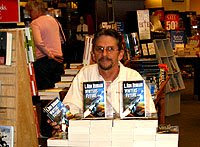 Modern noir mysteries anchor the genre in its 70+ year history with the temper of emotion mentioned in the first post regarding this style of writing. Which is this: the mood of good noir mystery fiction should be set in the first page, paragraph, or in the first sentence. The mood must be dark, emotional, and command my attention, make me desire to know more.
Modern noir mysteries anchor the genre in its 70+ year history with the temper of emotion mentioned in the first post regarding this style of writing. Which is this: the mood of good noir mystery fiction should be set in the first page, paragraph, or in the first sentence. The mood must be dark, emotional, and command my attention, make me desire to know more.Previously, I posted first sentence examples of writers from 50+ years ago. The modern writers I've selected may need more than one sentence. The opening in each provides a hook, a lead-in that carries the reader's mind onward until the he gets a feel for the plot.
I'll start with J.D. Robb AKA Nora Roberts. The first book in her "Death" series is titled: Naked in Death.
She woke in the dark. Through the slats of the window shades, the first murky hint of dawn slipped, slanting shadowy bars over the bed. It was like waking in a cell.
The first sentence is too short to pull me in, but does make me wonder why, and who is she? By the end of the paragraph, I was ready to read the story.
Next, James Lee Burke's first noir mystery The Neon Rain uses a different style first sentence.
The evening sky was streaked with purple, the color of torn plums, and a light rain had started to fall when I came to the end of the blacktop road that cut through twenty miles of thick, almost impenetrable scrub oak and pine and stopped at the front gate of Angola Penitentiary.
Yes, that’s one sentence. Filled with imagery that even rouses taste sensation. Importantly, Burke totally captured my attention. His character, unknown to me at the time I first read this, had the perceptions of a man who saw life around him in a way I did not, could not. I wanted to know why, who he might be, and why he confronted a penitentiary.
Next John Sandford's first noir mystery Rules of Prey reverts to old style set up.
A rooftop billboard cast a flickering blue light through the studio windows. The light ricocheted off glass and stainless steel: an empty crystal bud vase rimmed with dust, a pencil sharpener, a microwave oven, peanut-butter jars filled with colored drawing pencils, paintbrushes and crayons. An ashtray filled with pennies and paper clips. Jars of poster paint. Knives.
Sandford began with images straight out of early 1950s noir, built on it, and pulled the reader visually through succeeding decades and landed him in place where he stared at knives. He needed a paragraph, but it works.
And last, Larry Schliessmann's first noir mystery Beholden is set in 1950. This demands a different style of plot buildup. Almost the reverse of the Sandford example.
466 people died on the nations highways over the four-day Fourth of July weekend.
A teenage kid playing a quarter of a mile from the Polo Grounds in a park on the Bronx side of the Harlem River, fired a .45 automatic into the air in celebration of Independence Day. One of the rounds came back to earth and snuffed out the life of an innocent bystander William Boyle several blocks away.
And GIs died again but this time in a place across the globe named Pohang Falls, Korea.
The calendar in my Flatiron Building second floor office remained on June 1950. I noticed it before I turned away from the only death that occurred during the long weekend that directly affected me.
Took a little longer, but the build up was intended to bring the reader to a time and place most of us never knew. The irony of the kid shooting and killing an unknown victim sets a tone of opinion expressed by the protagonist, and actually happened as described back in 1950. And of course, the Korean War had begun, and the protagonist's concern over the conflict indicates he might be a veteran himself. By this point, the reader has a preliminary grasp on the current events of the time, knowledge of location, and in the end the awareness that a different death demands the protagonist's interest, the one in his office. Might the corpse be a message?
Above are four distinctly different styles of modern noir mystery fiction. Each writer sets a tone, a mood, adds the emotional darkness noir demands, and leads the reader to a point where he wants to know more.
I'll dig in deeper in my next post.
In the words of the immortal Alfred Hitchcock: "Good Evening."
Technorati Tags:
writer's block, schliessmann, marlowe black, liz dokker, noir mystery, gumshoe, private detective, PI, hacker mckaybees, plots, antagonist, protagonist, character, authors, southernyankee, noirmystery, mickey spillane, synopsis, query, writer, readers, writers, authors, book tour, query letter























